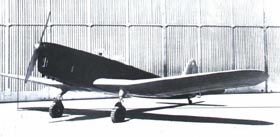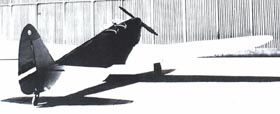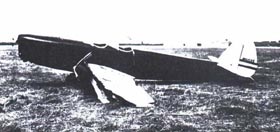In the middle of 1939 tenders were invited, by the
Air force Command, for the choice of a new type of home - manufactured aircraft for the
basic pilot training, which should have replaced already old-fashioned biplanes
"Fizir FN".
The Rogozarski aircraft factory decided to enter the
competition by engaging two, by then already well recognized aircraft engineers, Eng. D.
Miroslav Nenadovic and Milenko Mitrovic, who devoted their energy to this complex task.
It was stipulated that the new aircraft should be a
low-winged aircraft and by this ensuring the easier transition to the advanced fighters,
low-winged monoplanes, such as was Hurricane, or rather Me-109E, or IK-3. For the power
plant was selected the British engine Gypsy Major, which had been already used in some
foreign aircraft of the same or similar purpose.
The aircraft was named after the first-year student
in high schools or colleges who are called-freshmen. The construction of the prototype was
initiated already at the beginning of October 1939 and, by the end of February 1940, as it
was recorded in a document, already 80 % of the work was done and the production was being
kept only by waiting for the delivery of the shock-absorbers for the undercarriage and
skid from Great Britain.
The aircraft finally took off at the beginning of
May 1940 from "Beograd" airport, and the pilot was, most probably, Milos Gagic,
aircraft factory Rozarski test pilot at that time.
After a series of factory's testing "The
Freshman" was first handed over to the "Optina grupa", and after that the
aircraft was flown by the instructors of the First and Second pilot school at Pancevo and
Kraljevo, who were to evaluate its usability in carrying out the training of the new
pilots. During one of the flights of the familiarization with the aircraft’s
characteristics, an incident occurred on June 20, 1940 at Kraljevo. The instructor
Vladimir Obad, after a normal landing, plunged the left wheel into the soft ground, what
resulted in breaking of the longeron and other damages.

The repairment of the aircraft at the factory was
exploited to eliminate some of the noticed defects, and by the end of October, 1940 the
flights were proceeded with in Belgrade.
In the meantime, an opinion was submitted to the
Command, according which the "Freshman" had also, beside some positive
characteristics, quite a number of shortcomings. They were particularly obvious in the
construction much as unpracticality of the wing made in one piece, this being unpractical
for the
transport and repairs. It was also pointed out at
the inappropriateness of the system for handling of brakes. During the flight, the
aircraft did not allow bigger mistakes, which was important for the initial training, and
in case of losing speed it would abrugtly lose height to the left side and could be
recovered with pretty difficult only. Because of all that, the opinion of the commission
was that the "Freshman" should not be put into assembly-line production.
The same destiny had another competitor in the
competition, the aircraft "Alka", constructed by engineer Anton Kuhelj.
As the most advantageous was evaluated "Aero
2", which was constructed for the Ikarus factory by engineers Petkovic and Cijan.
But the Rogozarski factory did not give up easily, and
requested additional testing and new members of the commission. In November, 1940 all the
three competitors flew in front of the special commission leady by the air force commander
personally.
Finally, the winner was "Aero 2", which was after World War 2 produced in
big series and in different variants. |
|
|
Engineer
Boris Cijan, one of the constructors, once also a test pilot himself, has told the author
of this text, that the "Freshman" was in fact a good plane and that it had
better characteristics than "Aero 2" during landing and better climb, but
"Aero 2" was more steerable and better for aerobatics. But in the meantime,
wishing to find a market for the plane, the Rogozarski factory designed a seaplane version
of the "Freshman", with a more powerful Czech-made powerplant "Walter
Six", 140 KW/190 HP and with metal floats made by the Canadian firm "Edo".
This design was offered to the Marine Command at the end of October 1940 as a seaplane for
basic training.

When Yugoslavia was attacked on April 6, 1941 a prototype of
the "Freshman" was in the hangar of the Opitna Grupa at the "Beograd"
airport.
From there it was flown over, as ordered by the commanding
officer of the First fighter brigade group captain Dragutin Rupcic, to the auxiliary field
near Veliki Radinci by one of the off duty pilots of the 6th air force regiment.
It is supposed that after two days it was burnt down by our
airmen, because of the impossibility to take off and nearness of the German troops.
PAINTING AND MARKING
Aircraft body, without tail section, was painted in Crimson,
otherwise favourite painting of the constructor Mitrovic, i.e. of his wife.
With the same paint were painted wheels, legs and mudguards,
wing, landing gear fairing and the before mentioned parts of the body were painted in grey
which was very similar to the German RLM 02 grau. By the way, in our airman's slang this
paint was known also as "gull grey".
Unpainted were left the metal parts; cabin wind-shield's
frames, uncovered part of the landing gear, spinner, the pitot tube and the leather
sheathing on the edges of the cabin.
These metal parts are polished, the propeller is lacquered in
brown, which on the interior side is matt.
Of national insignia there was only a small dimension
national flag on both sides of the rudder.
The factory emblem, stylised aircraft in a round-shaped ring,
painted white on the bright-blue round base, on the top of the vertical fin on both sides.
Above the flag the name of the plane is written on the left in
Latin letters, on the right in Cyrillic. Although the lettering is different, the
construction of letters is identical. There is no indication that any additional
inscription was put later on.

SPECIFICATIONS
Construction-cantilever low-wing monoplane, wooden
construction, two-seater.
Tapered wing with chamfers, horizontal in the central
section, where are flaps, while outer ends are raised 5,7°. The wing has two spars and it
is completely covered with beech cardboard.
The plane has no position lights, and at the ends of the
wings there are towing grapples. Differential ailerons, wooden construction.
by Cedomir Janic |